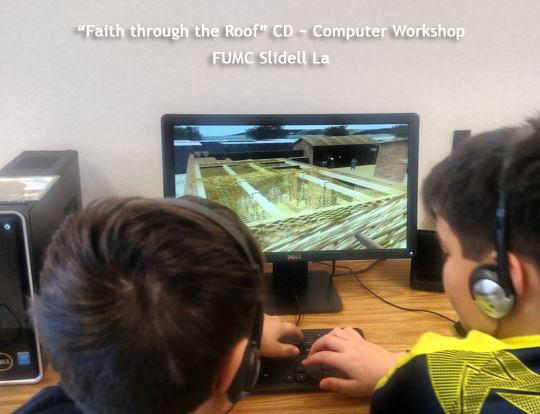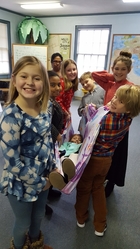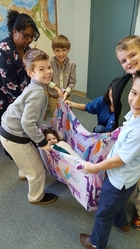Jesus and the Man Let Down Through the Roof
Games Workshop
Summary:
The children will play a game to explore the level of faith and commitment of the friends who carried the paralyzed man to see Jesus. They will also consider ways in which they can bring the needs of others to Jesus, and close with a special "Locking Arms to Look for Jesus" prayer.
Scripture Reference:
Mark 2:1-12, also Matthew 9:2-8 and Luke 5:17-26
Memory Verse:
“Let us stop just saying we love each other; let us really show it by our actions.” 1 John 3:18 (NLV)
Lesson Objectives
At the end of the session, the students will
- know that it was not easy for the four friends to carry their friend to Jesus but they had faith and found a way.
Teacher preparation in advance:
- Read the scripture passages and lesson plan and attend the Bible Study, ...
- Prepare a closing prayer.
- Learn the memory verse.
- To our teachers at RCC: The design of this workshop is very intentional. The activities and discussion questions for this workshop were designed to meet the goals of the entire rotation and the educational objectives of the Rotation Model (tm) at River Community Church. While we feel it is important to follow the serendipitous leading of the Holy Spirit, please do not change the lesson plan without consulting a Curriculum Planning and Writing Team member.
- Check out the room before your first Sunday workshop so that you know where everything is located.
- The cabinet with supplies is located in the big Sunday School room. Purchase or request additional supplies from --by October 3.
- Make the stretchers.
- Send a notice home suggesting that girls wear shorts or pants on the day they attend this games workshop. (sample above)
- Write the memory verse on a poster and on index cards for the memory verse game.
Room set-up:
Set-up a path for the children to follow (outside, weather permitting).
Supply List:
- Bibles
- "Stretchers" (see instructions below)
- cones or chairs or flowerpots or something to mark the path
- Memory verse words on individual index cards (2 or 3 sets, so that you will have about 4 children per set)
- Memory verse written on posterboard or a flipchart
- Consider having shorts or pajama pants or something for girls who wear dresses to cover up with
- Memento: consider having some sort of sticker to reward cooperative participation in the games
- Shepherd Time: whiteboard or flipchart with markers; plain paper and markers and pens and pencils
Supplies for optional games: - Caring Carriers: beach towels (1 for each group of 4) and inflated balloons (1 for each group plus a few extra in case of “accidents") – you can draw faces on them so they look like friends.
- Nimble Limbo: long stick (such as a yardstick or broomstick)
- For each stretcher, you need:
- 2 poles, each 6 or 7 feet long (small tree trunks and 2 x 2 lumber are good options)
- A piece of heavy fabric, 5 to 6 feet long (leftover upholstery fabric, old blankets or bedspreads are good sources)
- Large safety pins
- Duck tape
- Upholstery thread or other heavy thread
- A sewing machine
MAT OR "STRETCHER" INSTRUCTIONS
 If you have enough of a "mat" or blanket, then kids can pull their teammate who is sitting on it. To make the "mat" or "stretchers" for the game you can either use old wool "army" blankets, or likewise size pieces of burlap or cheap muslin cloth. A canvas paint tarp or blue tarp works too! (They make one that's long and skinny and can be cut into "mats" that your kids can pull).
If you have enough of a "mat" or blanket, then kids can pull their teammate who is sitting on it. To make the "mat" or "stretchers" for the game you can either use old wool "army" blankets, or likewise size pieces of burlap or cheap muslin cloth. A canvas paint tarp or blue tarp works too! (They make one that's long and skinny and can be cut into "mats" that your kids can pull).
If you want to make it a little more fun like a "stretcher," try this: STAPLE your canvas drop cloth, blue tarp, or blanket to two 2x4's, and have the player lay down on the mat while their teammates pick up ONE END of the 2x4 and drag them across the floor. Note: Do not let them pick up all four corners of the 2x4s as that can create a tipping/fall problem.
TIP: We recommend a bike helmet for the person being dragged on the mat or the stretcher.
LESSON
Opening:
Greet the children and introduce yourself. Explain what they'll be doing and learning about today.
Study the Story:
Read the scripture: Luke 5:17-26. Explain that this story is told in three of the Gospels – we are reading from Luke today. Have the children locate the story passage in their Bibles. Review the organization of the Bible: The Bible is divided into two big parts, the Old and New Testaments. Each part is a collection of books. Each book is divided into chapters and verses. Show them that if they open their Bible in the middle, they will usually land in the book of Psalms in the OT. Point out that the book name is at the top of each page. Tell them that Luke is the third book of the New Testament and it comes after Matthew and Mark. After they have found Luke tell them to find Luke 5:17-26. Some of the children may confuse chapters and verses. Show them that chapter numbers are the big ones, and also are at the top of every page (in most editions).
For classes composed primarily of pre-readers, show the children how to find the passage in the Bible and then have them do it. After everyone has found the passage, have them close their Bibles and listen while you read.
Play!
Divide the class into groups of five or six children. (Try to have groups where the children are all about the same size.) Have them practice carrying each other on the stretcher the way the paralyzed man’s friends carried him to Jesus. (See stretcher-making instructions in the supply list.)
SAFETY: Emphasize that the man’s friends cared very much about him so they carried him carefully and worked together. Everybody should pick up and put down their poles at the same time. If one person sets his pole down before the others, their friend will get dumped onto the ground. If anyone finds his load too heavy, he should tell the others so they can all set down the stretcher together.
Go outside where you have created a course for each team, marked into several equal legs. The courses can be triangles, squares, or straight lines marked into sections. The distances should be long enough to require a little effort, but not so long as to be discouraging.
Give each group a stretcher. One child is to lie on the stretcher, while four children carry it the first leg of the course. They then switch positions so that a different child is carried for the next leg. If you have more than five children in a group, rotate the participants so they all have a turn as spectators. Repeat until everybody has had a ride. If needed, remind the children that speed is not the object. They are to carry the friend on the stretcher carefully. NO RACING!
Alternative for younger children or if you are concerned that the children can’t carry each other: Use weights or 40 lbs of rice, etc., double wrapped to prevent spillage. If you use this alternative for older children, use more weight.
If the weather prevents you from going outside, let the children carry each other around the room on the stretchers. Use tables, chairs, or whatever is available to make a course, or just clear out a space and let them take 2 or 3 minute turns carrying and riding.
FIELD TEST NOTE: This was great fun, and I, the great worrier (Amy  ) was skeptical, but I helped out one Sunday and no one was hurt and everyone was careful and respectful -- even the 2nd grade boys who occasionally are a bit more rough and rambunctious than I care for. This was easier for the smaller children. For the older/bigger/heavier children, you will want at least one adult to assist with the carrying.
) was skeptical, but I helped out one Sunday and no one was hurt and everyone was careful and respectful -- even the 2nd grade boys who occasionally are a bit more rough and rambunctious than I care for. This was easier for the smaller children. For the older/bigger/heavier children, you will want at least one adult to assist with the carrying.
Encourage pairs to decide how they will go under the stick before their turn to try.
As each pair makes it under the stick successfully, applaud.
"You did a really good job helping each other and leaning on one another. In fact, sometimes the only way to get under the stick is with the help of a friend."
Reflect:
Pulling it all together (closing discussion):
- Was it hard work to carry your friends?
- I wonder why the friends in the Bible story would work that hard (carry the man to the house, up the stairs to the roof, dig a hole in the thatch, tie ropes to the mat, and lower him down) to get their friend to Jesus?
- What did the man in the story need from Jesus?
- I wonder what things your friends need that you could ask Jesus for?
- I wonder how you can bring your friends to Jesus? (Let them know you are praying for them. Invite them to church. Talk to them about God. Think of things you can do to help them.)
Review the memory verse.
Read the memory verse from a poster together. Divide the class into groups of about 4 children. Give each group a set of index cards with one word of the verse written on each card. Have them put the words in order. Encourage them to help their friends get the job done.
A Locking Arms to Look for Jesus Closing:
Write this prayer on the board and then play it:
Begin in a circle and have the teacher go lock arms with a student as you both say this prayer together: “Thank you God for ____ (name everyone you are locked with). Help us to help each other and other people to see you more clearly and follow you more closely. Amen.” Now the two of you go lock arms with a third student and everyone repeats the prayer. Then the three of you locks arms with a fourth person, ...and so on.
Additional Suggestions:
Be sensitive to children who are noticeably different size than the majority of the class (both bigger and smaller). Try to match teams of like-sized children rather than friends.
You will need to decide how best to adjust the lesson for older and younger students. Keep the children active and involved in activity. Do what works for you and the children. In addition to the suggestions included in the lesson plan, for younger children:
- For classes composed primarily of pre-readers, show the children how to find the passage in the Bible (for example, “To find the Gospels, open the Bible in the middle and then open the second half in the middle - you should end up in Matthew, Mark, Luke, or John. Our passage is in Luke.") and then have them do it. After everyone has found the passage, have them close their Bibles and listen while you read.
- In the stretcher game, make the course shorter.
- In the limbo game, the Workshop Leader and the Shepherd should hold the stick.
This lesson was written by Jamie Senyard for River Community Church, Prairieville, Louisiana.
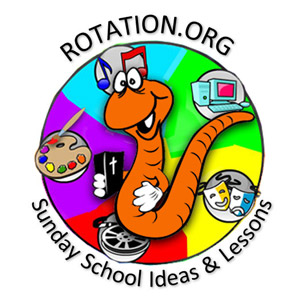
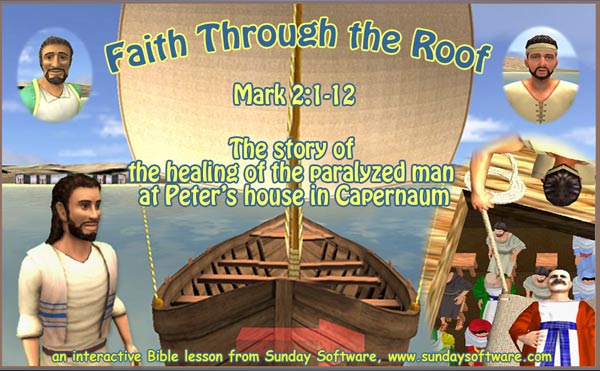
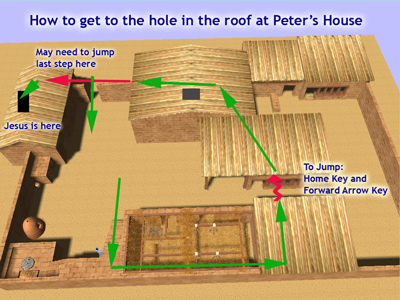

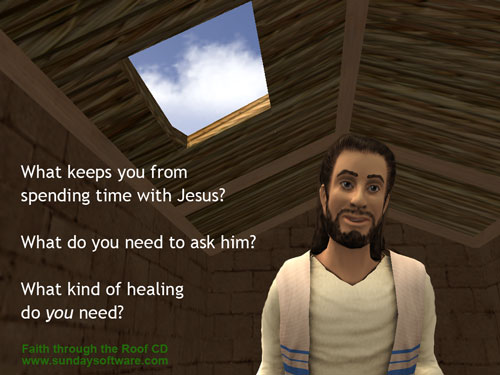

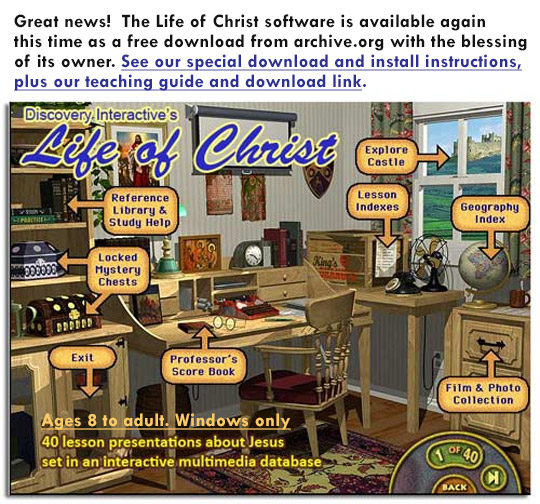

 If you have enough of a "mat" or blanket, then kids can pull their teammate who is sitting on it. To make the "mat" or "stretchers" for the game you can either use old wool "army" blankets, or likewise size pieces of burlap or cheap muslin cloth. A canvas paint tarp or blue tarp works too! (They make one that's long and skinny and can be cut into "mats" that your kids can pull).
If you have enough of a "mat" or blanket, then kids can pull their teammate who is sitting on it. To make the "mat" or "stretchers" for the game you can either use old wool "army" blankets, or likewise size pieces of burlap or cheap muslin cloth. A canvas paint tarp or blue tarp works too! (They make one that's long and skinny and can be cut into "mats" that your kids can pull).
